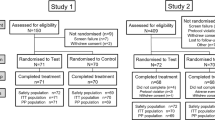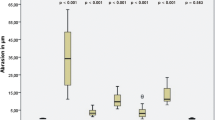Abstract
Objectives
The aim of the study was to determine in situ the relative abilities of two desensitising toothpastes to occlude dentinal tubules with or without acid challenge.
Materials and methods
The study design was a single centre, randomised, split mouth crossover model examining four treatments over two periods. The primary outcome was the degree of occlusion proffered by two desensitising toothpastes [Sensodyne® Rapid Relief (8% strontium acetate, 1040 ppm sodium fluoride) and Colgate® Sensitive Pro-ReliefTM daily (8% arginine, 1450 ppm sodium monofluorophosphate)], a standard toothpaste (1450 ppm sodium fluoride) and water, after acid challenge. Healthy adult volunteers wore bi-lateral lower buccal appliances each with two dentine sections, receiving two treatments per study period. Samples were brushed twice a day with treatment, with two additional 3-min extra-oral acidic challenges applied ex vivo on days 3 and 4. A secondary outcome was the degree of occlusion attained in the absence of acid challenge. Examiners blinded to the study assessed occlusion by visual score of post-treatment scanning electron microscope images.
Results
All 28 participants completed the study. In the absence of acid challenge, occlusion scores for both desensitising toothpastes were similar and significantly better than control scores (p < 0.02). After acid challenge both desensitising toothpastes occluded more effectively than controls; however, occlusion scores for the strontium acetate paste were significantly greater than those of the arginine paste (p < 0.02).
Conclusions
The occluding properties of the strontium acetate toothpaste were significantly more robust after acid challenge than those of the arginine toothpaste.
Clinical relevance
Patients with hypersensitivity, regularly imbibing dietary acidic drinks, should be advised that Sensodyne® Rapid Relief provides robust tubule occlusion despite repeated acidic challenges.


Similar content being viewed by others
References
Gillam DG, Aris A, Bulman JS, Newman HN, Ley F (2002) Dentine hypersensitivity in subjects recruited for clinical trials: clinical evaluation, prevalence and intra-oral distribution. J Oral Rehabil 29:226–231
Holland GR, Narhi MN, Addy M, Gangarosa L, Orchardson R (1997) Guidelines for the design and conduct of clinical trials on dentin hypersensitivity. J Clin Periodontol 24:808–813
Rajapakse PS, McCracken GI, Gwynnett E, Steen ND, Guentsch A, Heasman PA (2007) Does toothbrushing influence the development and progression of non-inflammatory gingival recession? A systematic review. J Clin Periodontol 34:1046–4061
Addy M (2005) Tooth brushing, tooth wear and dentine hypersensitivity—are they associated? Int Dent J 55:261–267
Absi EG, Addy M, Adams D (1987) Dentine hypersensitivity. A study of the patency of dentinal tubules in sensitive and non-sensitive cervical dentine. J Clin Periodontol 14:280–284
Markowitz K, Pashley DH (2008) Discovering new treatments for sensitive teeth: the long path from biology to therapy. J Oral Rehabil 35:300–315
Brännströmm M, Årstrom A (1972) The hydrodynamics of the dentin: its possible relationship to dentinal pain. Int Dent J 22:219–227
Mason S, Hughes N, Sufi F, Bannon L, Maggio B, North M, Holt J (2010) A comparative clinical study investigating the efficacy of a dentifrice containing 8% strontium acetate and 1040 ppm fluoride in a silica base and a control dentifrice containing 1450 ppm fluoride in a silica base to provide immediate relief of dentin hypersensitivity. J Clin Dent 21:42–48
Davies M, Paice EM, Jones SB, Leary S, Curtis AR, West NX (2011) Efficacy of desensitizing dentifrices to occlude dentinal tubules. Eur J Oral Sci 229:497–503
Schiff T, Saletta L, Baker RA, Winston JL, He T (2005) Desensitising effect of a stabilized stannous fluoride/sodium hexametaphosphate dentifrice. Compend Contin Educ Dent 26:35–40
Cummins D (2009) Dentin hypersensitivity: from diagnosis to a breakthrough therapy for everyday sensitivity relief. J Clin Dent 20:1–9
Kleinberg I (2002) Sensistat. A new saliva-based composition for simple and effective treatment of dentinal sensitivity pain. Dent Today 21:42–47
Ayad F, Ayad N, Zhang YP, DeVizio W, Cummins D, Mateo LR (2009) Comparing the efficacy in reducing dentin hypersensitivity of a new toothpaste containing 8% arginine, calcium carbonate and 1450 ppm fluoride to a commercial sensitive toothpaste containing 2% potassium ion: an eight-week clinical study on Canadian adults. J Clin Dent 20:10–16
Docimo R, Montesani L, Maturo P, Costacurta M, Bartolino M, Devizion W, Zhang YP, Cummins D, Dibart S, Mateo LR (2009) Comparing the efficacy in reducing dentin hypersensitivity of a new toothpaste containing 8.0% arginine, calcium carbonate, and 1450 ppm fluoride to a commercial sensitive toothpaste containing 2% potassium ion: an eight-week clinical study in Rome, Italy. J Clin Dent 20:17–22
Nathoo S, Delgado E, Zhang YP, DeVizio W, Cummins D, Mateo LR (2009) Comparing the efficacy in providing instant relief of dentin hypersensitivity of a new toothpaste containing 8.0% arginine, calcium carbonate, and 1450 ppm fluoride relative to a benchmark desensitizing toothpaste containing 2% potassium ion and 1450 ppm fluoride, and to a control toothpaste with 1450 ppm fluoride: a three-day clinical study in New Jersey, US. J Clin Dent 20:123–130
Layer T, Hughes N (2010) Evidence for the efficacy of an 8% strontium acetate dentifrice for instant and lasting relief of dentin hypersensitivity. J Clin Dent 21:56–58
Saleeb FZ, Debruyn PL (1972) Surface properties of alkaline earth apatites. J Electroanal Chem 37:99–118
Kun L (1982) Biophysical study of the modification of dental tissues caused by local application of strontium. Swiss Month Rev Odontostomatol 86:661–676
Absi EG, Addy M, Adams D (1995) Dentine hypersensitivity: uptake of toothpastes onto dentine and effects of brushing, washing and dietary acid. J Oral Rehabilil 22:175–182
Addy M, Mostafa P (1989) Dentine hypersensitivity II. Effects produced by the uptake in vitro of toothpastes onto dentine. J Oral Rehabil 16:35–48
Banfield N, Addy M (2004) Dentine hypersensitivity: development and evaluation of a model in situ to study tubule patency. J Clin Periodontol 31:325–335
Claydon NCA, Addy M, MacDonald EL, West NX, Maggio B, Barlow A, Parkinson C, Butler A (2009) Development of an in situ methodology for the clinical evaluation of dentine hypersensitivity occlusion ingredients. J Clin Dent 20:158–166
Parkinson CR, Butler A, Willson RJ (2010) Development of an acid challenge-based in vitro dentin disc occlusion model. J Clin Dent 21:31–36
Parkinson CR, Willson RJ (2011) An in vitro investigation of two currently marketed dentin tubule occlusion dentifrices. J Clin Dent 22:6–10
Hughes N, Mason S, Jeffery P, Welton H, Tobin M, O’Shea C, Browne M (2010) A comparative clinical study investigating the efficacy of a test dentifrice containing 8% strontium acetate and 1040 ppm sodium fluoride versus a marketed control dentifrice containing 8% arginine, calcium carbonate, and 1450 ppm sodium monofluorophosphate in reducing dentinal hypersensitivity. J Clin Dent 21:49–55
Giles A, Claydon N, Addy M, Hughes N, Sufi F, West NX (2009) Clinical in situ study investigating abrasive effects of two commercially available toothpastes. J Oral Rehabil 36:498–507
Dababneh RH, Khouri AT, Addy M (1999) Dentine hypersensitivity—an enigma? A review of the terminology, epidemiology, mechanisms, aetiology and management. Br Den J 187:606–611
British Soft Drinks Association (2011) The 2011 UK soft drinks report. http://www.britishsoftdrinks.com/ Home Page » News » Press Releases». Accessed 22 July 2011
West NX, Davies M, Amaechi BT (2011) In vitro and in situ erosion models for evaluating tooth substance loss. Caries Res 45:43–52
Adult Dental Health Survey (2009) http://www.ic.nhs.uk/webfiles/publications/007_Primary_Care/Dentistry/dentalsurvey09/AdultDentalHealthSurvey_2009_Theme1_Oralhealthandfunction.pdf. Accessed 31 August 2011
Petrou I, Heu R, Stranick M, Lavender S, Zidel L, Cummins D, Sullivan RJ, Hsueh C, Gimzewski JK (2009) A breakthrough therapy for dentin hypersensitivity: how dental products containing 8% arginine and calcium carbonate work to deliver effective relief of sensitive teeth. J Clin Dent 20:23–31
Sauro S, Watson TF, Thompson I (2010) Dentine desensitization induced by prophylactic and air-polishing procedures: an in vitro dentine permeability and confocal microscopy study. J Dent 38:422–422
Millward A, Shaw L, Harrington E, Smith AJ (1997) Continuous monitoring of salivary flow rate and pH at the surface of the dentition following consumption of acidic beverages. Caries Res 31:44–49
Hughes JA, West NX, Parker DM, Newcombe RG, Addy M (1999) Development and evaluation of a low erosive blackcurrant juice drink in vitro and in situ 3. Final drink and concentrate. Formulae comparisons in situ and overview of the concept. J Dent 27:345–350
Wegehaupt FJ, Gunthart N, Sener B, Attin T (2011) Prevention of erosive/abrasive enamel wear due to orange juice modified with dietary supplements. Oral Dis 17:508–514
Min JH, Kwon HK, Kim BI (2011) The addition of nano-sized hydroxyapatite to a sports drink to inhibit dental erosion—in vitro study using bovine enamel. J Dent 39:629–935
Ranjitkar S, Rodriguez JM, Kaidonis JA, Richards LC, Townsend GC, Bartlett D (2009) The effect of casein phosphopeptide-amorphous calcium phosphate on erosive enamel and dentine wear by toothbrush abrasion. J Dent 37:250–254
West N, Addy M, Jackson RJ, Ridge BD (1997) Dentine hypersensitivity: review and discussion of controls and the placebo response. A comparison of the effect of strontium acetate and potassium nitrate toothpastes on dentine hypersensitivity. J Clin Periodontol 24:209–215
Curro FA, Friedman M, Leight SR (2000) Design and conduct of clinical trials on dentine hypersensitivity. In: Addy M, Embery G, Edgar WM, Orchardson R (eds) Toothwear and sensitivity. Martin Dunitz, London, pp 299–315
West N (1996) Dentine hypersensitivity: clinical and laboratory studies of toothpastes and their ingredients and acids. PhD Thesis, University of Wales College of Medicine
Acknowledgement
This study was sponsored by the University of Bristol, and funding for the study was donated by GlaxoSmithKline Consumer Healthcare.
Conflicts of interest
None of the authors are aware of any conflict of interest arising from conducting and reporting the findings of this study.
Author information
Authors and Affiliations
Corresponding author
Additional information
National Research Ethics Service register number: 10/H0206/66
Rights and permissions
About this article
Cite this article
Seong, J., Macdonald, E., Newcombe, R.G. et al. In situ randomised trial to investigate the occluding properties of two desensitising toothpastes on dentine after subsequent acid challenge. Clin Oral Invest 17, 195–203 (2013). https://doi.org/10.1007/s00784-012-0683-7
Received:
Accepted:
Published:
Issue Date:
DOI: https://doi.org/10.1007/s00784-012-0683-7




